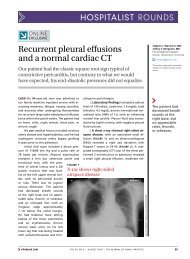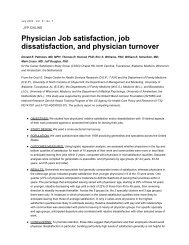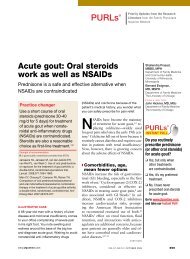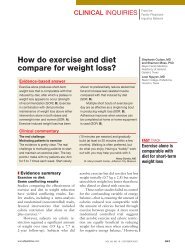Clinical Inquiries - The Journal of Family Practice
Clinical Inquiries - The Journal of Family Practice
Clinical Inquiries - The Journal of Family Practice
Create successful ePaper yourself
Turn your PDF publications into a flip-book with our unique Google optimized e-Paper software.
extracorporeal shock-wave application for treatment <strong>of</strong><br />
chronic plantar fasciitis. J Bone Joint Surg Am 2002;<br />
84-A:335–341.<br />
6. Ogden JA, Alvarez R, Levitt R, Cross GL, Marlow M.<br />
Shock wave therapy for chronic proximal plantar fasciitis.<br />
Clin Orthop 2001; 387:47–59.<br />
7. Buchbinder R, Ptasznik R, Gordon J, Buchanan J,<br />
Prabaharan V, Forbes A. Ultrasound-guided extracorporeal<br />
shock wave therapy for plantar fasciitis: a randomized<br />
controlled trial. JAMA 2002; 288:1364–1372.<br />
8. Davies MS, Weiss GA, Saxby TS. Plantar fasciitis: how<br />
successful is surgical intervention? Foot Ankle Int 1999;<br />
20:803–807.<br />
9. <strong>The</strong> diagnosis and treatment <strong>of</strong> heel pain. J Foot Ankle<br />
Surg 2001; 40:329–340.<br />
Does physical therapy<br />
improve symptoms<br />
<strong>of</strong> fibromyalgia?<br />
■ EVIDENCE-BASED ANSWER<br />
Physical therapy is minimally effective in the<br />
treatment <strong>of</strong> fibromyalgia, with immediate posttreatment<br />
improvement in pain and tender points,<br />
and both short- and longer-term improved<br />
self-efficacy (confidence in performing tasks)<br />
(strength <strong>of</strong> recommendation [SOR]: B, 1 small,<br />
high-quality randomized controlled trial, 4 additional<br />
small randomized controlled trials).<br />
Multidisciplinary rehabilitation is probably<br />
not effective for this disorder but warrants future<br />
research, as trial quality is poor (SOR: B,<br />
systematic review <strong>of</strong> 4 small or low-quality and<br />
3 additional randomized controlled trials on<br />
widespread pain conditions).<br />
■ EVIDENCE SUMMARY<br />
<strong>The</strong> goal <strong>of</strong> physical therapy is to maximize function<br />
and reduce impairment to limit disability in<br />
patients with musculoskeletal conditions. 1 Based<br />
on a British study, physical therapists most<br />
commonly use exercise, education about correct<br />
posture and functional activity, relaxation, and<br />
energy conservation and fatigue management. 2<br />
For this review, physical therapy is defined as a<br />
treatment program that includes patient education<br />
and supervised exercise.<br />
CLINICAL INQUIRIES<br />
In the highest-quality trial, Buckelew and<br />
colleagues 3 randomized 119 subjects to 1 <strong>of</strong> 4<br />
groups: bi<strong>of</strong>eedback and relaxation training,<br />
exercise training, combination treatment, and an<br />
education and attention control program.<br />
Individuals were evaluated on measures <strong>of</strong> pain,<br />
function, disease impact, and self-efficacy.<br />
Evaluators were blinded to treatment group.<br />
Patients were followed for 2 years, and follow-up<br />
information was available on 85% <strong>of</strong> patients.<br />
At immediate postintervention follow-up, all<br />
treatment groups were significantly improved on<br />
tender-point index score compared with the<br />
control group, but this was due to a modest deterioration<br />
for the control group rather than<br />
improvements in the treatment groups. In addition,<br />
all groups showed improvements in selfefficacy<br />
for function compared with the control<br />
group but not for other self-efficacy measures.<br />
While within-group improvements in the treatment<br />
groups were seen, no significant differences<br />
were seen from the control group.<br />
Another trial randomized 99 patients to 3<br />
groups: education and cognitive behavioral therapy;<br />
education, cognitive behavioral therapy and<br />
exercise; or a wait-list control group. 4 At the<br />
6-month follow-up, the education group scored<br />
significantly higher than the others—but only on<br />
self-reported measures <strong>of</strong> daily functioning and<br />
self-efficacy.<br />
In another study, 45 patients with fibromyalgia<br />
were randomly assigned to a 6-week program<br />
combining exercise and multidisciplinary education<br />
or to a control group. 5 <strong>The</strong> treatment group<br />
had significant improvements in walking distance<br />
and for 2 measures on the Fibromyalgia Impact<br />
Questionnaire (feeling bad and morning fatigue).<br />
Keel and colleagues 6 found no immediate treatment<br />
benefit following 15 weeks <strong>of</strong> education,<br />
cognitive behavioral therapy, and exercise vs<br />
relaxation training in their small randomized<br />
controlled trial. 6<br />
In contrast, another study reported significant<br />
and immediate improvements in 2 groups—<br />
exercise and education; exercise, education, and<br />
CONTINUED<br />
SEPTEMBER 2003 / VOL 52, NO 9 · <strong>The</strong> <strong>Journal</strong> <strong>of</strong> <strong>Family</strong> <strong>Practice</strong> 717








